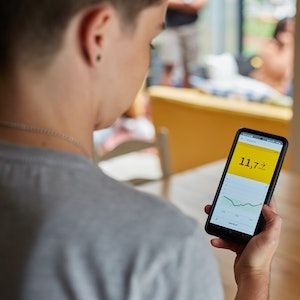Article
Diabetes Distress Remains Greater in People with T1D, Impaired Awareness of Hypoglycemia
Author(s):
Widespread use of continuous glucose monitoring was not found to attenuate the association between impaired awareness of hypoglycemia and diabetes-related distress.
Credit: sweetlifediabetes/unsplash

Diabetes-related distress was a persistent problem among people with type 1 diabetes (T1D), particularly for those with impaired awareness of hypoglycemia (IAH), according to new research.1
High usage of continuous glucose monitoring (CGM) technology did not seem to attenuate the association between impaired awareness of hypoglycemia and distress, suggesting the need for further approaches to sufficiently eliminate diabetes distress.
“Despite greater concern about their IAH, individuals with IAH were not more motivated to restore IAH and had less faith in its recovery,” wrote the investigative team, led by Namam Ali from the department of internal medicine at Radboud University Medical Center. “The use of sensor technology did appear to mitigate the association between IAH and diabetes-specific distress, although distress seemed to have been diminished among individuals with restoration of IAH after introduction of a glucose sensor.”
Previous literature has indicated the commonality of hypoglycemia among individuals with T1D as potentially an unavoidable complication of insulin therapy. For these individuals, recurrent hypoglycemia may induce habitation and can lead to IAH down the line.2 The investigative team points out that individuals with T1D and IAH may experience high levels of diabetes-specific distress, a product of dealing with the needs and limitations related to the chronic disease.
Those with IAH could experience higher diabetes-specific distress due to a higher risk for severe hypoglycemia events, leading to more stress about these events and a greater fear of hypoglycemia. Linked to both improved glycemic outcomes and a reduction in the incidence of hypoglycemia, CGM use has also been shown to reduce diabetes-specific distress. For this analysis, Ali and colleagues aimed to compare diabetes-specific distress (emotions, cognitions, behaviors) in people with T1D and either IAH or normal awareness of hypoglycemia (NAH) in a contemporary cohort with a high uptake of glucose sensors.1
The single-center cross-sectional study was performed at Radboud University Medical Centre’s outpatient diabetes clinic from February 2020 - April 2021, including patients with T1D ≥16 years of age. Of 702 individuals with T1D assessed for eligibility, 422 were enrolled in the study (51.9% male; diabetes duration, 30 years). Participants completed the Clarke questionnaire to assess hypoglycemia awareness status, Problem Areas in Diabetes (PAID-5), Hypoglycemia Fear Survey-II (HFS-II), Attitudes to Awareness of Hypoglycemia Survey (A2A), Nijmegen Clinical Screening Instrument Survey (NCSI), and Hyperglycemia Avoidance Scale (HAS).
Approximately 88% of study participants reported using a glucose sensor for a median duration of 12 months and 19.4% of participants reported IAH (n = 82). Upon analysis, investigators observed high diabetes-related emotional distress (PAID-5 score of ≥8) was present in 24.2% (n = 102) of individuals. Data showed the high scores were more prevalent in individuals with IAH compared to those with NAH (35.4% vs. 21.5%; P = .008), with higher total PAID-5 scores in the individuals with IAH.
The analysis showed participants with IAH also had higher scores on all HFS-II sub scores (P <.001), including HFS behavior (P = .005), HFS-II worry (P <.001), HAS worries (P <.001), and NCSI hypoglycemia items. However, HAS behavior, A2A, and NCSI hyperglycemia scores were not found to be different between individuals with or without IAH. Sensitivity analyses revealed the results for the diabetes-specific distress questionnaires were generally similar when restricted to participants using CGM technology.
“Apparently, widespread use of CGM technology has not closed this gap between IAH and NAH,” investigators wrote. “Further studies are needed to investigate intervention strategies, whether psychological or technological, to lower diabetes-specific distress, particularly in individuals who retain IAH despite the use of a sensor.”
References
- Ali N, El Hamdaoui S, Nefs G, Walburgh Schmidt JWJ, Tack CJ, de Galan BE. High diabetes-specific distress among adults with type 1 diabetes and impaired awareness of hypoglycemia despite widespread use of sensor technology [published online ahead of print, 2023 Jun 22]. Diabet Med. 2023;e15167. doi:10.1111/dme.15167
- McNeilly AD, McCrimmon RJ. Impaired hypoglycaemia awareness in type 1 diabetes: lessons from the lab. Diabetologia. 2018; 61(4): 743- 750.





